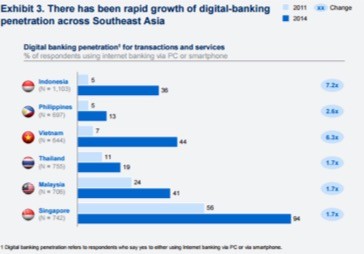Popular Reads
Top Results
Can't find what you're looking for?
View all search resultsPopular Reads
Top Results
Can't find what you're looking for?
View all search resultsHow new digital banks can bring banking to the edge
Neobanks need to ensure that security for their edge infrastructure is closer to the customer, in order to respond to cyberthreats quickly.
Change text size
Gift Premium Articles
to Anyone
I
t is expected that four years from now, more than half the people in Southeast Asia will have switched to neobanks or challenger digital banks. We are rolling headlong fast in this digital-first banking evolution and the unfolding pandemic has only sped things up.
The region has always been a digital banking hotbed, even pre-pandemic. Since 2010, 200 digital challenger banks have been set up globally. Of these, 46 are in Asia Pacific. No doubt by 2025, there will be more players on the scene, including five that have jumped on the digital banking bandwagon in Indonesia and another seven that are still in the process.
Emerging technologies such as edge computing will set the contenders apart. The right technology will not only power speed and reliability of service, it will also ensure data security. Not least, it will determine the bank’s capability of delivering a world-class digital application experience.
Edge computing plays a big part in the seamless, fuss-free customer experience we have come to expect of digital banking (and other apps and devices, too). From sign-up to first payment in a few taps, to transferring money in seconds, and logging in with a facial scan, convenience is the calling card of digital-first banking.
The name “edge computing” defines its nature. Data processing takes place near the source of the data, the ‘edge’ of the network. Data does not have to travel to a cloud exclusively to be processed. Instead, edge computing allows computing to take place at one of the intermediate storage and processing points on the network.
Since enterprises can store and process their data near their users, they are able to deliver fast, seamless service. This explains how you can access your digital banking service in fractions of a second after scanning your thumb or face. This swift data processing is also what powers the neobank’s ability to deliver personalized services – a defining feature of digital banking.
Real-time access to personalized intelligence allows banks to deliver relevant, up-to-date content specific to you. This could be product recommendations, or bespoke advice in your financial journey. Hit your savings goal? Need to balance your savings portfolio? Your neobank app will be able tell you that.
But speedy service and a great customer experience are only possible with robust security in place. Neobanks need to invest in technology that will protect the business (and your money) from the fast-evolving menace of cyberthreats such as Denial of Service (DDoS), data breaches, phishing, and ransomware attacks.
Neobanks need to ensure that security for their edge infrastructure is closer to the customer, in order to respond to cyberthreats quickly. These security solutions include web application firewalls, bot management, and DDoS mitigation, reinforced by technologies such as artificial intelligence and machine learning. Processing at the edge can vastly improve data security by ensuring confidential data is being processed and masked prior to transit upstream, reducing the risk of a data leak.
Just as technology empowers new banks to deliver innovative products in the financial services industry, it also arms them with an arsenal to establish a strong cyber defense. The guarantee of robust security backing the neobank’s business build trusts and credibility, ultimately cementing the neobank’s reputation as safe and trustworthy
New digital banks must play the long game if they want to come up on top. That means delighting the customers with more value-added services while keeping their prices competitive.
However, adding services such as marketplaces and personal financial management tools drives up cost, with the increase in volume of data to be processed and stored. However, edge technology provides neobanks with cost-effective data processing solutions to grow their business in phases within budget, as they continually enrich the customer experience.
As more neobanks come on the scene, technology will play a vital role in setting them apart. It will shape their quality on all fronts: from user experience and data security to its agility in scaling up the business. And it will, ultimately, determine the neobank’s longevity.
***
The writer is country manager, F5, a multi-cloud application security and delivery company.










